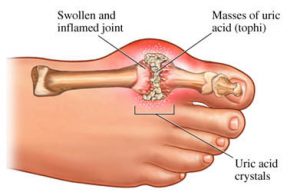Gout: Root Causes and a Natural Treatment Approach
Do you have severe pain in your great toe that feels like sharp needles stabbing you every time you take a step? Has this pain limited your ability to stand or walk? Is that “Gout”? 
According to the Arthritis Foundation, gout occurs in about 6 million men and 2 million women, or around 4% of American adults. Gout is a painful condition that occurs when too much uric acid, a body waste product, is produced. High amounts of uric acid in your body can deposit crystals that are needle-sharp in your joints. These crystals cause inflammatory arthritis of the joint which leads to redness, swelling, heat, pain, and limited mobility of the joint.
Where does gout present?
Most people who suffer from gout have symptoms in their big toe, but many other joints and areas around the joints can be affected. Gout is commonly found in the insteps, ankles, heels, and knees. Some people have upper body symptoms in the wrists, fingers, and elbows. High amounts of uric acid not only affect the joints, but can collect in your kidneys leading to painful kidney stones.
What causes gout?
Gout, similar to many other diseases, is usually caused by multiple triggers. There are some triggers that we cannot avoid, but many that we can control. Gout is more common in men than women, especially if you are under the age of 60. Gout is genetic, so if someone in your family had it, you are more at risk. Individuals that also have heart disease, diabetes, high cholesterol or high blood pressure are more at risk. If you take certain medications such as diuretics or “water pills” or immune suppressing medications, you are more at risk. Individuals that eat a diet high in red meat, shellfish, organ meat (liver, tongue, and sweetbreads) or who drink 2 plus glasses of alcoholic or sugary beverages per day produce more uric acid in their body systems.
Treatment for gout
Acute treatment of gout is to decrease inflammation and pain. Rest, stay off and elevate your feet. Apply ice to the area with a small amount of compression. Non-steroidal Anti-inflammatory Drugs (NSAIDs) or Corticosteroids are commonly prescribed by your medical doctors to help alleviate pain and get over the inflammation phase. These are great for the short term painful stage of gout, but most of us don’t want to be dependent on drugs forever. The goal is to prevent these gout attacks and decrease the chance of another episode.
The most natural approach is to make small changes in your diet and lifestyle. Developing a lifelong eating strategy that focuses on decreasing uric acid levels and promoting heart-health is the key! This diet includes all food groups, especially vegetables, whole grains, plant proteins (nuts, legumes) and low-fat dairy. Processed foods and refined carbohydrates should be kept to a minimum.
The list below are foods that will help to LOWER your body’s uric acid levels.
- All vegetables
- Skim milk and other low fat dairy products
- Whole grain foods
- Plant oils (olive, canola, sunflower)
- Some fruits (citrus fruits and those that are less sweet)
- Vitamin C supplements (500-1000 milligrams daily)
- Coffee – if you already drink it (1-2 cups a day without sugar or sweeteners)
- Water
Long term relief
These nutritional guidelines will help you to decrease your body’s overall uric acid levels, which will help solve the gout root cause and not just manage the symptoms. Reaching and maintaining a healthy weight is an important step in managing gout. Obesity causes gout to start at an early age and increases your chances of having an attack. Eating the “recommended” foods will decrease your total body uric acid levels dramatically, thus reducing your chances of a gout attack, while also improving your total body health! It all comes back to the age old saying: “You are what you eat… so eat well!”
For further information or question about a painful joint please call us at (828)348-1780.

